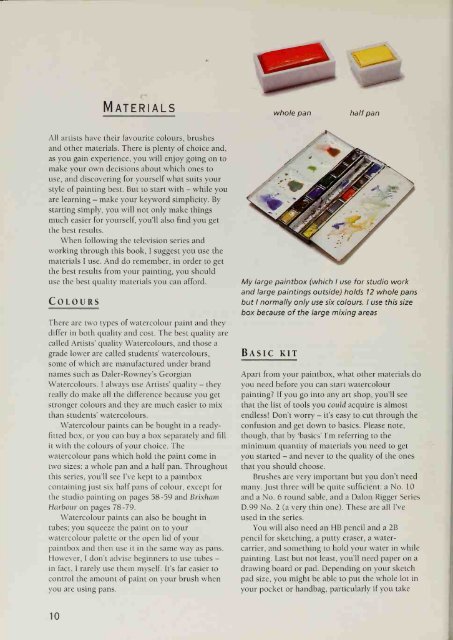A Brush With Art.pdf
You also want an ePaper? Increase the reach of your titles
YUMPU automatically turns print PDFs into web optimized ePapers that Google loves.
Materialswhole pan half panAll artists have their favourite colours, brushesand other materials. There is plenty of choice and,as you gain experience, you will enjoy going on tomake your own decisions about which ones touse, and discovering for yourself what suits yourstyle of painting best. But to start with - while youare learning - make your keyword simplicity. Bystarting simply, you will not only make thingsmuch easier for yourself, you'll also find you getthe best results.When following the television series andworking through this book, I suggest you use thematerials I use. And do remember, in order to getthe best results from your painting, you shoulduse the best quality materials you can afford.ColoursThere are two types of watercolour paint and theydiffer in both quality and cost. The best quality arecalled <strong>Art</strong>ists' quality Watercolours, and those agrade lower are called students' watercolours,some of which are manufactured under brandnames such as Daler-Rowney's GeorgianWatercolours. I always use <strong>Art</strong>ists' quality - theyreally do make all the difference because you getstronger colours and they are much easier to mixthan students' watercolours.Watercolour paints can be bought in a readyfittedbox, or you can buy a box separately and fillit wdth the colours of your choice. Thewatercolour pans which hold the paint come intwo sizes: a whole pan and a half pan. Throughoutthis series, you'll see I've kept to a paintboxcontaining just six half pans of colour, except forthe studio painting on pages 58-59 and BrixhamHarbour on pages 78-79.Watercolour paints can also be bought intubes; you squeeze the paint on to yourwatercolour palette or the open lid of yourpaintbox and then use it in the same way as pans.However, 1 don't advise beginners to use tubes -in fact, I rarely use them myself. It's far easier tocontrol the amount of paint on your brush whenyou are using pans.My large paintbox (which I use for studio workand large paintings outside) holds 12 whole pansbut I normally only use six colours. I use this sizebox because of the large mixing areasBasic kitApart from your paintbox, what other materials doyou need before you can start watercolourpainting? If you go into any art shop, you'll seethat the list of tools you could acquire is almostendless! Don't worry - it's easy to cut through theconfusion and get down to basics. Please note,though, that by 'basics' I'm referring to theminimum quantity of materials you need to getyou started - and never to the quality of the onesthat you should choose.<strong>Brush</strong>es are very important but you don't needmany. Just three will be quite sufficient: a No. 10and a No. 6 round sable, and a Dalon Rigger SeriesD.99 No. 2 (a very thin one). These are all I'veused in the series.You will also need an HB pencil and a 2Bpencil for sketching, a putty eraser, a watercarrier,and something to hold your water in whilepainting. Last but not least, you'll need paper on adrawing board or pad. Depending on your sketchpad size, you might be able to put the whole lot inyour pocket or handbag, particularly if you take10


